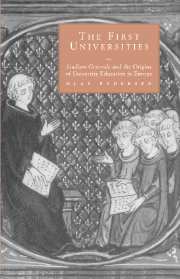Book contents
- Frontmatter
- Contents
- Preface
- Preface to the English edition
- List of abbreviations
- 1 The classical inheritance
- 2 From ancient science to monastic learning
- 3 The Carolingian Renaissance
- 4 The schools of the middle ages
- 5 From school to studium generale
- 6 The battle for the universities
- 7 Structure and form of government
- 8 The material situation
- 9 The road to degrees
- 10 Curricula and intellectual trends
- Index of names
3 - The Carolingian Renaissance
Published online by Cambridge University Press: 03 November 2009
- Frontmatter
- Contents
- Preface
- Preface to the English edition
- List of abbreviations
- 1 The classical inheritance
- 2 From ancient science to monastic learning
- 3 The Carolingian Renaissance
- 4 The schools of the middle ages
- 5 From school to studium generale
- 6 The battle for the universities
- 7 Structure and form of government
- 8 The material situation
- 9 The road to degrees
- 10 Curricula and intellectual trends
- Index of names
Summary
In and around AD 800 the cultural situation in western Europe underwent a series of important transformations which are normally described as the Carolingian Renaissance. This was not a spontaneous expansion of the inherent cultural energy of the west, rather a reaction to political events which, in the last analysis, can be traced back to the appearance of Islam on the political stage. Here we must go back to the year 622, when Mohammed transferred his activity from his birthplace Mecca to the nearby Medina, from which the Arab expansion took off soon after. Firstly, the Arab peninsula was united, and after the prophet's death in 632, one after the other the surrounding countries were subjected to the power of the Arabs. Damascus was conquered in 635, and Jerusalem fell two years later. In 638 the Arabs were overlords of parts of Mesopotamia, and from 640 to 641 Alexandria and most of Egypt yielded, while the whole of Persia was subdued in 643. Thereby the whole of the Near East was united under the caliphs of the Umajjad dynasty in Damascus, and Jews, Christians, and Mohammedans were forced into a kind of coexistence which would be of great cultural significance in the course of time. Then it was the turn of North Africa, and in 711 the ‘Moors’ crossed to Spain, where the last king of the Visigoths, Rodrigo, fell a couple of years later. Shortly afterwards the first Arab troops appeared north of the Pyrenees.
- Type
- Chapter
- Information
- The First UniversitiesStudium Generale and the Origins of University Education in Europe, pp. 67 - 91Publisher: Cambridge University PressPrint publication year: 1998



